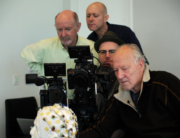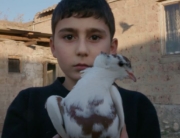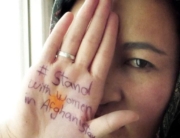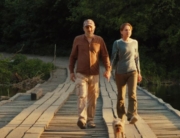There can be a certain charm, as well as an exasperating quality, to learning about the way things used to be, especially when the time is the 1960s and ’70s, the place is New York, and those in question are artists. We have heard the story often enough it is easy to take it for granted. The vitality of the various cultural scenes; the movie theaters, bookstores, and concert venues that used to exist; the cheap rent that was to be had; the embrace of eccentricity to which longtime residents attest: It’s a given that all this is easy to romanticize (and perhaps to misrepresent). Yet, as those interviewed here see the city drifting farther and farther from the one that once excited them, it becomes a story they need to tell.
Photographer James Hamilton is one such artist who made the most of a vanished time. He dropped out of Pratt Institute to become a photographer’s assistant and, with a break to be a clerk in a record store (with none other than musician Lenny Kaye as a coworker), worked as a professional photographer ever since. He hitchhiked across the country to photograph rock festivals (with a forged press pass) at a time when this was less dangerous. He eventually landed a staff position at The Village Voice, which gave him immense freedom and brought him into even greater contact with the wide variety of people he would strikingly capture with his camera. This list included celebrities and everyday people of all stripes. He did similar work for The New York Observer, then was a set photographer for Wes Anderson. And, get this, he has kept the same enormous (I’m sure rent-controlled) Manhattan apartment since the summer he dropped out of Pratt, where he does all his development and has a darkroom. He seems to have lived a Bohemian dream.
Uncropped, D.W. Young’s documentary about Hamilton’s incredible career, does sport many of the flaws typical of the genre. There are the numerous talking heads, from Thurston Moore to Anderson, who breezily expound on Hamilton’s importance in a tone that comes dangerously close to sycophancy, and a (at times) routine nostalgia for a New York that once was. Yet the film is still a lot of fun in spite of that and often earns its yearning for times past and its enthusiasm for its subject.
It is easy to see, from the portfolio on view throughout, how singular and striking Hamilton’s photography is and was. Many of the speakers isolate the specifics why this is so—his classical precision; his ability to make his subject seem utterly themselves; a fondness for an odd, offsetting detail. One particular photo of band members of the Soft Machine sitting in a hotel lobby near a woman who is just a bystander wonderfully encapsulates the specificity of his work. Aesthetic discussions are especially revealing when he and Sylvia Plachy (the other longtime photographer for the Voice) compare and contrast their work, with many relevant examples.
Where this documentary really shines is when The Village Voice becomes the subject. The surviving writers, editors, as well as Hamilton and Plachy, illustrate what made the newspaper vital and groundbreaking, and justly bemoan that such a venture does not seem possible in the current media landscape. Not only do they discuss the exciting subjects of the paper’s heyday (Off-Off Broadway, punk music, performance art), but they describe the argumentative, fiery culture in the office; the genuine commitment of the writers to explore all things strange and off the beaten path; and most impressively, the way the writers were granted but also fought for their freedom. When the magazine was bought by Rupert Murdoch, a strike brought the notoriously power-hungry tycoon to his knees, and the magazine continued on without the owner’s harassment.
Hamilton takes something of a backseat in these sections, and this is telling, for it reveals the film’s greatest weakness. Though his work is incredible and deserving of attention, Hamilton’s success is seemingly one of an almost frictionless ascent to prominence. His life story is, with some exceptions, a long list of accomplishments and of famous people he has been lucky enough to photograph—at least, this is how Young has told that story. Some of the more difficult subjects Hamilton had to photograph are dealt with only in passing, and little to nothing is said about their impact on him. He did a fair amount of war photography in places as varied as Ethiopia and El Salvador, and was present in Beijing for the Tiananmen Square Massacre. Not once does he talk about how he may have been affected by photographing a corpse, except for a brief comment on the emotional toll of his work in Ethiopia. He has much to say, however, about the afternoon he spent with Alfred Hitchcock.
There is still plenty in this subject to explore.







Leave A Comment